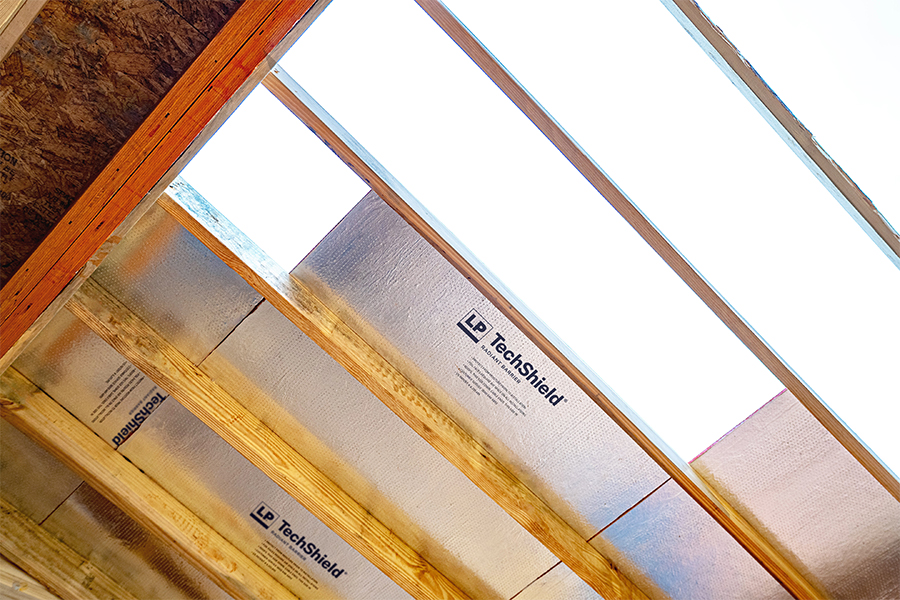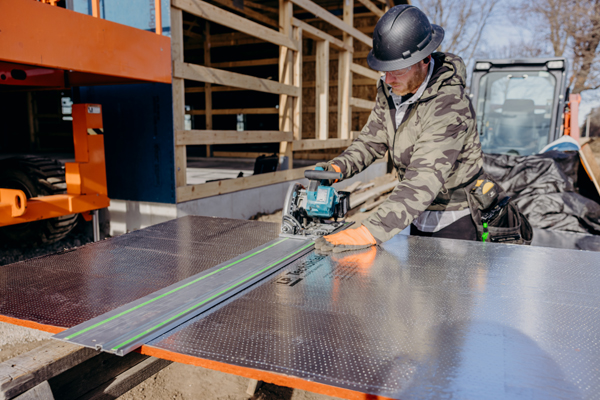Menu
Business Advice7 min
LP® TechShield® FAQ: Addressing Common Questions About Radiant Barriers
If you haven’t used one before on a build, you may have questions about radiant barrier sheathing products—how they impact a build, how to install them and more.
We connected with Billy Webb, LP Structural Solutions Product Manager, to get some of the most common questions about radiant barriers answered in a brief FAQ about LP® TechShield® Radiant Barrier. Read more to explore how a radiant barrier can impact your next build.
What is a radiant barrier?
“A radiant barrier is a layer of reflective material installed under the roof deck to redirect the radiant heat created by the sun,” says Webb. LP TechShield Radiant Barrier does just that, and it also features VaporVents™ technology, created with our post-lamination foil incising process. This helps create a highly effective radiant barrier because it helps block radiant heat from entering your attic while allowing trapped moisture in the panel to escape.

How does a radiant barrier help save on energy costs?
According to Webb, when you can control your attic temperatures you are also helping control the temperatures in your house. “Blocking up to 97% of radiant heat and reducing attic temperatures by up to 30° F. This may help increase the efficiency of your attic-installed air handling system as well as create savings over the lifetime of your home,” he adds.
Are there any special considerations for LP TechShield panels that a builder should know when it comes to installation?
“One of the best parts about LP TechShield panels is that they install just like conventional sheathing,” says Webb, “with no added installation or labor costs.” With easier installation, it can be a simple option to help lower HERS ratings and help achieve a Net Zero home.

How can LP TechShield panels and insulation products work together?
LP TechShield Radiant Barrier can be used in vented and unvented attic spaces, and it can be combined with ceiling insulation as well as spray foam insulation at the roof deck. “Ceiling insulation is the easiest route,” Webb says. “LP TechShield Radiant Barrier is a plug and play. You can also bury your ducts if you’re looking for an unconditioned attic space option.”
In order to install LP TechShield panels in attics with spray foam, Webb points to a solution from LP. “It’s not suggested to install spray foam directly on the roof deck, as it could cause shingle manufacturer warranty concerns along with moisture and wood rot concerns,” he notes. “We suggest the builder install an attic baffle to achieve the minimum ¾-inch air gap needed between the LP TechShield panels and the spray foam.”
With extreme weather events on the rise, Webb mentions that more roofs are being replaced—and even more roof decks. “The air gap method makes a roof deck repair even easier,” he says. “Since the spray foam is attached to the baffle, you no longer need to remove the spray foam if there is damage and the roof deck needs to be replaced. By combining the two you not only have a great insulation package, but you also have peace of mind about your shingle warranty not being voided, moisture issues in the roof deck and added repair costs.”
Ready for a deeper dive about radiant barriers? Explore the science behind heat transfer in attics.
Continue Reading
Business Solutions
4 minQ&A: How Home Orientation Impacts Continuous Insulation
There’s a lot to consider when it comes to building an energy-efficient home for your clients and the many nuances that change with each build—including its orientation to the sun.
Continue ReadingResiliency Solutions
5 minHOW A RADIANT BARRIER CAN IMPROVE BURIED DUCT PERFORMANCE
There are several insulation methods based on attic design, but ducts placed over the bottom of truss chords and buried under insulation in a vented attic is a popular builder option.
Sustainability Solutions
8 minHow to Drive Effective Communication and Collaboration on the Jobsite
Every jobsite has a ton of moving parts, from product shipments, supplies, and schedules to subcontractors and homeowners. It’s no wonder that many project teams can struggle to maintain quality jobsite communication and collaboration throughout the building process.
Sustainability Solutions
6 minCarbon Negative, Future Positive: LP® Structural Solutions Portfolio Releases Environmental Product Declarations
In an era where environmental responsibility is paramount, we are proud to announce a remarkable achievement: the LP® Structural Solutions portfolio has been officially designated as carbon negative. This milestone is a testament to our unwavering commitment to redefining construction materials for the better with a focus on sustainability, resiliency and groundbreaking advancements.